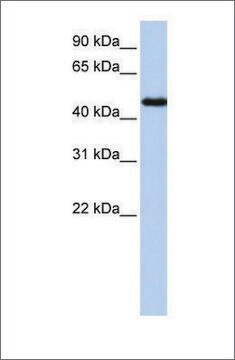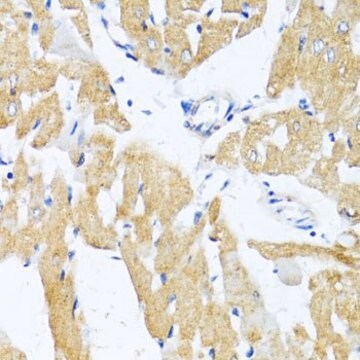ABE1425
Anti-COUP-TF1 Antibody
serum, from rabbit
Sinônimo(s):
COUP transcription factor 1, COUP-TF1, COUP transcription factor I, COUP-TF I, Nuclear receptor subfamily 2 group F member 1, V-erbA-related protein 3, EAR-3, COUP-TF1
About This Item
Produtos recomendados
fonte biológica
rabbit
Nível de qualidade
forma do anticorpo
serum
tipo de produto de anticorpo
primary antibodies
clone
polyclonal
reatividade de espécies
mouse, human, rat
técnica(s)
ChIP: suitable
immunofluorescence: suitable
immunohistochemistry: suitable
western blot: suitable
nº de adesão NCBI
nº de adesão UniProt
Condições de expedição
dry ice
modificação pós-traducional do alvo
unmodified
Informações sobre genes
mouse ... Nr2F1(13865)
rat ... Nr2F1(81808)
Descrição geral
Especificidade
Imunogênio
Aplicação
Immunofluorescence Analysis: An 1:500-1000 dilution of a representative lot detected COUP-TF1 immunoreactivity in the developing brain using paraformaldehyde-fixed cryosections from wild-type mouse E13.5 embryos, but not in embryos with brain region-specific COUP-TF1-knockout, by fluorescent immunohistochemistry (Courtesy of Dr. Michele Studer, Institut de Biologie Valrose, France).
Chromatin Immunoprecipitation (ChIP) Analysis: A representative lot detected COUP-TF1 occupancy at the conserved binding sites along the Rnd2 locus using chromatin preparations from the neocortices of E14.5 mouse embryos (Alfano, C., et al. (2011). Development. 138(21):4685-4697).
Western Blotting Analysis: A representative lot detected a higher COUP-TF1 level in retinal and retinal pigment epithelium (RPE) extracts from 24-week-old mice subjected to prorolonged light exposure (24 h/day) than from mice with normal light exposure (12 h/day). Light stress-induced COUP-TF1 upregulation was also observed in RPE, but not retinal extracts from Ranbp2+/− mice (Cho, K.I., et al. (2010). Dis. Model Mech. 3(9-10):595-604).
Western Blotting Analysis: A representative lot detected a 64 kDa form of COUP-TF1 co-immunoprecipitated with RNABP2 from murine retinal extracts (Cho, K.I., et al. (2010). Dis. Model Mech. 3(9-10):595-604).
Immunofluorescence Analysis: A representative lot detected cortex-specific COUP-TFI-knockout in the developing brain of E11.5 COUP-TFIfl/flEmx1Cre transgenic mouse embryos by fluorescent immunohistochemistry staining of paraformaldehyde-fixed cryosections (Armentano, M., et al. (2007). Nat. Neurosci. 10(10):1277-1286).
Immunofluorescence Analysis: A representative lot detected A representative lot detected COUP-TFI immunoreactivity in paraformaldehyde-fixed frozen coronal sections from wild-type E15.5 mouse embryos, but not from COUP-TFI-knockout embryos (Armentano, M., et al. (2006). Development. 133(21):4151-4162).
Immunofluorescence Analysis: A representative lot detected COUP-TF1 immunoreactivity associated with calbindin-positive GABAergic interneurons, but not reelin-positive Cajal-Retzius cells in the developing cortex by dual fluorescent immunohistochemistry using cryosections from E13.5 and E15.5 mouse embryos (Tripodi, M., et al. (2004). Development. 131(24):6119-6129).
Immunohistochemistry Analysis: A representative lot detected a different COUP-TF1 expression pattern than that of COUP-TF2 in the developing telencephalon of forebrain using cryosections from E13.5 mouse embryos (Tripodi, M., et al. (2004). Development. 131(24):6119-6129).
Epigenetics & Nuclear Function
Nuclear Receptors
Qualidade
Western Blotting Analysis: A 1:500 dilution of this antibody detected COUP-TFI in 20 µg of mouse brain tissue lysate.
Descrição-alvo
forma física
Armazenamento e estabilidade
Handling Recommendations: Upon receipt and prior to removing the cap, centrifuge the vial and gently mix the solution. Aliquot into microcentrifuge tubes and store at -20°C. Avoid repeated freeze/thaw cycles, which may damage IgG and affect product performance.
Outras notas
Exoneração de responsabilidade
Não está encontrando o produto certo?
Experimente o nosso Ferramenta de seleção de produtos.
Código de classe de armazenamento
12 - Non Combustible Liquids
Classe de risco de água (WGK)
WGK 1
Ponto de fulgor (°F)
Not applicable
Ponto de fulgor (°C)
Not applicable
Certificados de análise (COA)
Busque Certificados de análise (COA) digitando o Número do Lote do produto. Os números de lote e remessa podem ser encontrados no rótulo de um produto após a palavra “Lot” ou “Batch”.
Já possui este produto?
Encontre a documentação dos produtos que você adquiriu recentemente na biblioteca de documentos.
Nossa equipe de cientistas tem experiência em todas as áreas de pesquisa, incluindo Life Sciences, ciência de materiais, síntese química, cromatografia, química analítica e muitas outras.
Entre em contato com a assistência técnica






